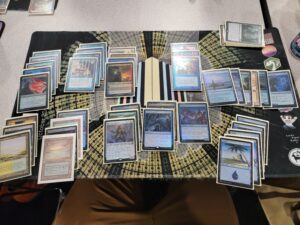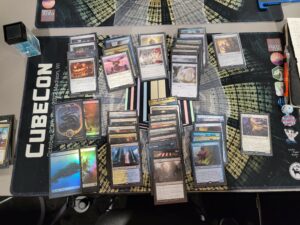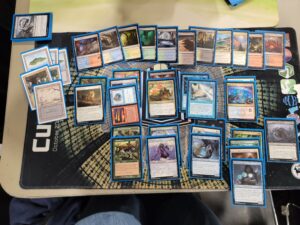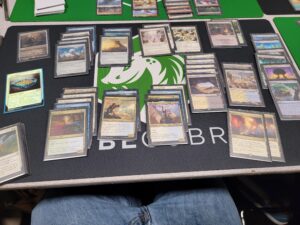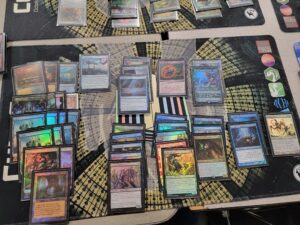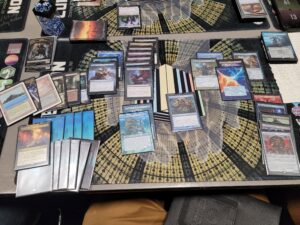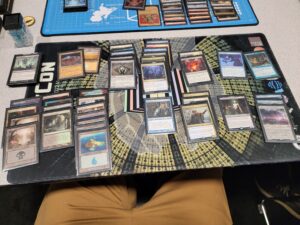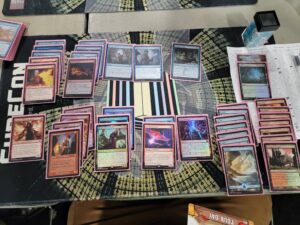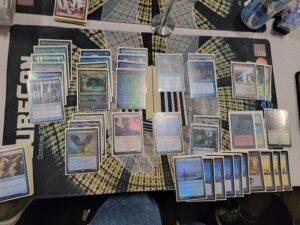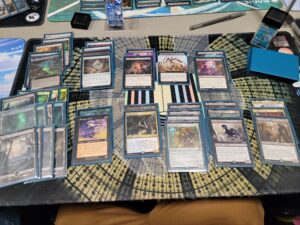It has been years since I’ve been this kind of tired. Four nights of minimal sleep buttressed four days absolutely jam-packed with Magic. Four days of unusually excellent convention food sustained me as I gathered with like-minded fellows within concrete halls untouched by the sun. It was absolutely glorious.
It’s going to take time to digest the entire experience. I had a wonderful time, played some great games of Magic, and witnessed awesome coverage. I had enthralling discussions about Magic and game design and how cube’s incomplete terminology makes it difficult to easily discuss. I made new friends, met digital friends in person for the first time, and got to know old friends and familiar faces from Grands Prix better. The first CubeCon was a success well-worth repeating and it was an honor to have my cube be part of it all. While I’d love to kick off a discussion on understanding the language of how people talk about cube, or what designers and players seek from creating and playing cubes, or interviewing the luminaries who heroically made this event happen, all of that will take time.
So instead, let’s go back to my earliest days of Hipsters of the Coast, back in 2013, and give you a sense of what CubeCon was like with a quick tournament report. I’ll share the ten decks I piloted from Thursday to Sunday and a selection of the most interesting experiences I had with them.
Deck #1: Scott’s Cube
The first day of CubeCon was dedicated to freeplay—anyone who could wrangle a group of drafters could play their cube. Some folks spent their entire four day weekend doing this, though most played at least some of the featured cubes on Friday and Saturday (where match wins and trophies were tracked for a cut to top 64 on Sunday).
My first draft of CubeCon was Scott’s. Scott is a wonderful human I met in NYC several months before CubeCon and his cube is sweet. It’s a Legacy-style cube with an abundance of fixing. If memory serves, it has duplicates of the fetchlands and Alpha dual lands, but I most appreciated his innovation of also including the Dominaria United common dual lands. Many Limited formats include both powerful fixing for multicolor-focused players to prioritize and weak fixing for desperate players to have turn to to in emergencies. It’s unusual for Legacy-style cubes to include much (or any) of the latter, but it worked so well to know one could wheel fetchable fixing.
This deck was a ton of fun to pilot. I think I went 2-1 or 2-0 with it—it desperately needed a fetchable white land to make the mana work, but alas, I didn’t find any Dominaria United plains.
Deck #2: Turbo Cube
This was the cube I was most looking to play on the weekend. The Turbo Cube has one special rule that dramatically alters all card evaluations: all spells and activated abilities cost 2 less. This means that Guild Globe is a Black Lotus for 2 mana that also draws a card. Oko, Thief of Crowns is one of the weakest cards in the format while Teferi’s Tutelage is one of the easiest ways to win the game on turn 1 (thanks to all the 0 mana cyclers).
This deck felt like a trainwreck with almost no fast mana, but it turns out that Control actually exists in Turbo Cube. Granted, the lategame starts on turn 3, so the challenge is mostly surviving your opponent’s first turn and finding ways to maintain parity in the midgame (aka turn 2). I had a blast, but it was exhausting. Imagine a thirty minute long game piloting a control/cube deck, then condense all of those game actions, decision trees, and time into a game’s first two turns. That is what it’s like playing Turbo Cube. It’s glorious and worth trying again… after a year or so of recovery.
Deck #3: Pauper Cube
Friday was the first day of CubeCon’s light tournament structure, which meant I was ready for some friendly competition with minimal stakes and the glory of making top 8 on the line. That’s exactly what I want from Magic and I can’t overemphasize how perfect CubeCon’s balance of competition and friendliness was.
The day was off to a bit of a rough start, as I think some no-shows meant we fired with only five people (and I had the bye round one, so I didn’t get to play right off the bat). That said, I know how to navigate five person pods pods—with so few packs, it’s hard to scrape together enough playables for a coherent two color deck. I already love prioritizing fixing, so that’s just what I did: draft lands, cheap interaction, and card advantage. My control deck did well enough to bring me to the finals where it promptly lost to a coherent aggro deck in three tight, fun games.
Deck #4: Regular Cube
This was among the lowest powered cubes at CubeCon, which was great for me. I love those kinds of cubes and this felt a whole lot like retail Limited (my favorite format of all). I’d practiced this one on CubeCobra a fair bit and felt like white/blue control had a high density of power level outliers like wraths and Shelldock Isle. I got passed everything I wanted, drafted plenty of fixing, and managed to get my trophy.
Arguably the most fun moment of playing CubeCon was how I won the finals. The cube’s designer loves the combo of Whitemane Lion and Oketra’s Monument, which essentially lets you create a 1/1 Vigilance warrior for one white mana. I had barely stabilized against my opponent (who was a great sport for letting me show off and had a phenomenal BR sacrifice deck), got to 20 cards in library, and activated my Shelldock Isle to cast Whitemane Lion. This began the combo, created an army out of nowhere, and ended by picking up Mystic Snake for style points. It felt great to let the cube designer watch someone do a thing that they want to happen in their cube, and later on, I’d get to experience the same.
Deck #5: Proliferate Cube
This was my worst-performing deck of the weekend at 1-2. I was a bit too tired to play optimally and I changed lanes a couple times in the draft, giving me a deck with plenty of fixing but insufficient interaction and power.
The critical moment happened in the first round. I mistook my Spara’s Headquarters for Raffine’s Tower as their promotional artworks look quite similar. I called a judge when I noticed the error, but a whole turn cycle had elapsed and the game state could not be repaired. The remedy at Regular Rules Enforcement Level is to play on, but I was deeply frustrated with myself and could tell that my opponent wasn’t happy, so I conceded the game and moved on to our third. I’m happy I did—I was playing to win, but I didn’t want to win by cheating (however unintentionally).
With that, Friday was over and I headed back to my hotel room, hungry for more Magic (and the dinner I’d skipped so I could play more cube).
Deck #6: Dekkaru Cube
This was by far and away my best deck of CubeCon. I abandoned my first few picks when I recognized Reanimator was open, committed hard to it, and managed to get my second trophy of the event. While I often enjoy winning with grindy decks that eke out value, play a bunch of colors, and pivot into being tempo decks when my opponents get a slower start, sometimes it’s nice to pilot something quick, consistent, and overwhelmingly powerful. The Dekkaru Cube is beautiful to look at, but I ended up getting the least experience playing with it because of how ruthlessly efficient my deck was.
Deck #7: Graveyard Cube
Remember how I said I enjoy grindy decks that eke out value, play a bunch of colors, and can pivot into being tempo decks? This was that to a T. If the game went long, I always won thanks to Emrakul, the Promised End. I even had the ability to deck opponents who could kill Emrakul by looping it with Volrath’s Stronghold. I didn’t love how miserable the deck made opponents as it won, nor did I love stumbling badly on mana against fellow Hipster Derek Gallen’s impressive aggro deck, but I still a great time going 2-1.
Deck #8: UMA-Inspired Cube
With my spot in the top 64 secure and the dangers of playing tired fresh in my mind, I finished Saturday off by drafting my own cube. I’d only ever gotten to draft it once, so it was still a novel experience—though I knew it well enough that I was confident I could play it well while exhausted.
My favorite moment was getting absolutely crushed in round 2. My opponent’s turn 1 was amazing: mountain, Faithless Looting, discard and cast two Blazing Rootwallas with Madness. I witnessed how happy he was to do something so incredibly unfair yet so utterly intended to happen in my cube. It was a pleasure losing to that, just as it was a pleasure losing a game in the third round to a player discovering how to kill me with Codex Shredder, Krark-Clan Ironworks and Second Sunrise. I ended 2-1, putting me in the top 10 players and solidly in the top 64.
Most importantly, I watched Scott draft a four color artifact pile (a deck I knew could be done but had scant confidence in its ability to be successful) and joyously earn his first trophy. Watching people having fun playing my creation was more meaningful that I’d have predicted. As a game designer, I know that people have had fun with my creations, but I almost never get to just see them have fun with a finished product. It’s one of the many reasons I’ll definitely be returning to CubeCon next year and submitting at least one new cube for next time.
Deck #9: Scott’s Cube, take 2
Saturday was not done quite yet. A few of us stuck around in the convention center, got some Chinese food at midnight, and snuck in one round with Scott’s Cube. I played one good match and slunk back to my hotel round after one in the morning.
Just before falling asleep, I slipped and fell in the bathroom, hit my head, and came to on the floor. I knew I’d been out for only a moment from the clock on the wall, but the experience was scary. I was alone in a hotel room, miles away from my closest friends, late at night. I’d had a mild concussion as a teenager and knew to check myself for nausea, headache, bleeding, dilated pupils, dizziness, and swelling, and I seemed to be fine. I had way too much adrenaline pumping to go to sleep for long. I ended up checked myself for symptoms every 45 minutes until giving up on sleep entirely. I resigned myself to doing poorly in the top 64 draft and miserable from getting hardly any sleep, but was above all thankful that I was okay.
Deck #10: BUG Cube
I was anxious to draft this cube, as it didn’t seem like my cup of tea. I was feeling better than I’d have expected despite the less-than-pleasant night before, and I knew I could perform under worse conditions thanks to my time at GP Orlando. I studied the list, identified that there was a small density of good spot removal and that mana acceleration and two-for-ones seemed good, so I drafted exactly that. This monoblack (with some light splashes) won every game where it accelerated on turn 2 and played a four drop on turn 3. The others were a mixed bag, and I ended up 2-1.
With that, my tournament was over and I got to watch a friend participate in the Vintage Cube top 8 draft. The coverage was excellent and I can’t think of a better person to take down the first CubeCon than Wisconson’s own cube professional, Caleb Durward.
With CubeCon in the rear view mirror, there’s so much to ruminate on. I want to really dig deep into how people can talk about cubes, about what I’ve learned about myself and cube communities at large, and about what I might want to design for CubeCon 2023. But those are articles for another time. Next up, there’s Magic 30 in Las Vegas, my last step before returning home. It’ll be a different experience, exciting in its own way and far more massive in scope (if a little less laser focused on me and people like me). More on that next time, once I’m home and Brother’s War previews are in full swing.
Zachary Barash (he/him) is a New York City-based game designer and the last commissioner of Team Draft League. He designs for Kingdom Death: Monster, has a Game Design MFA from the NYU Game Center, and does freelance game design. When the stars align, he streams Magic (but the stars align way less often than he’d like).

